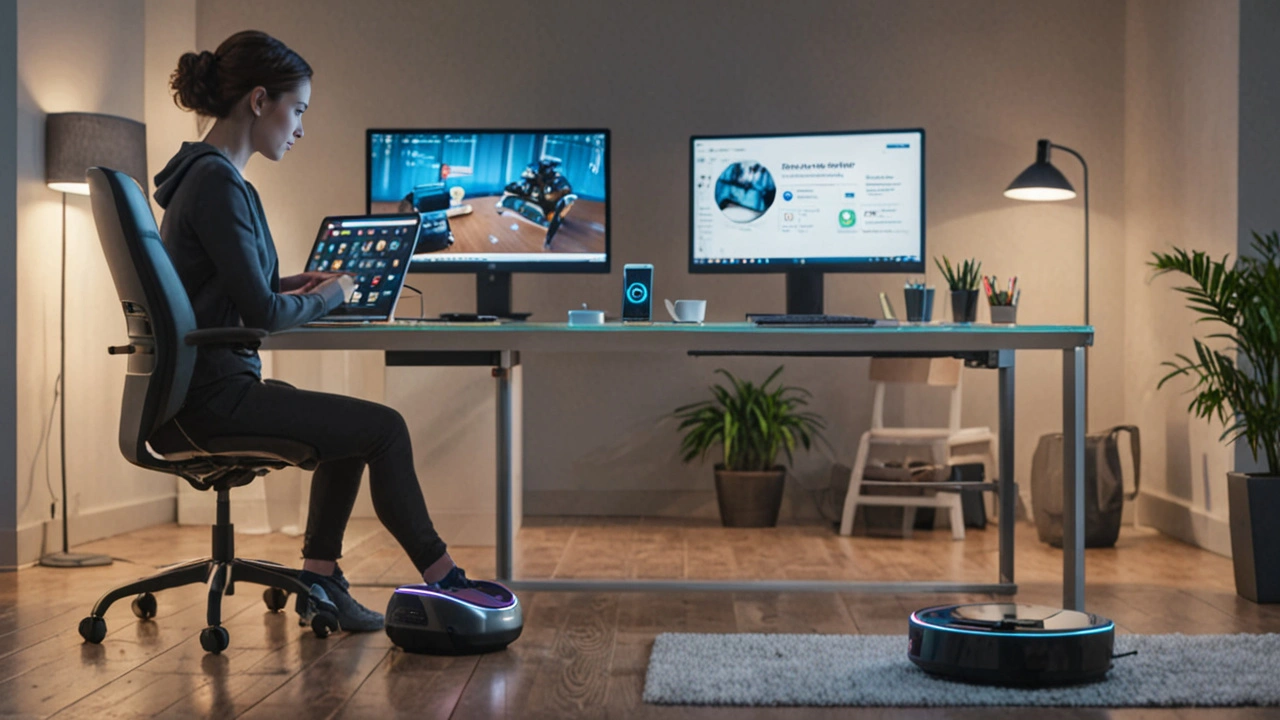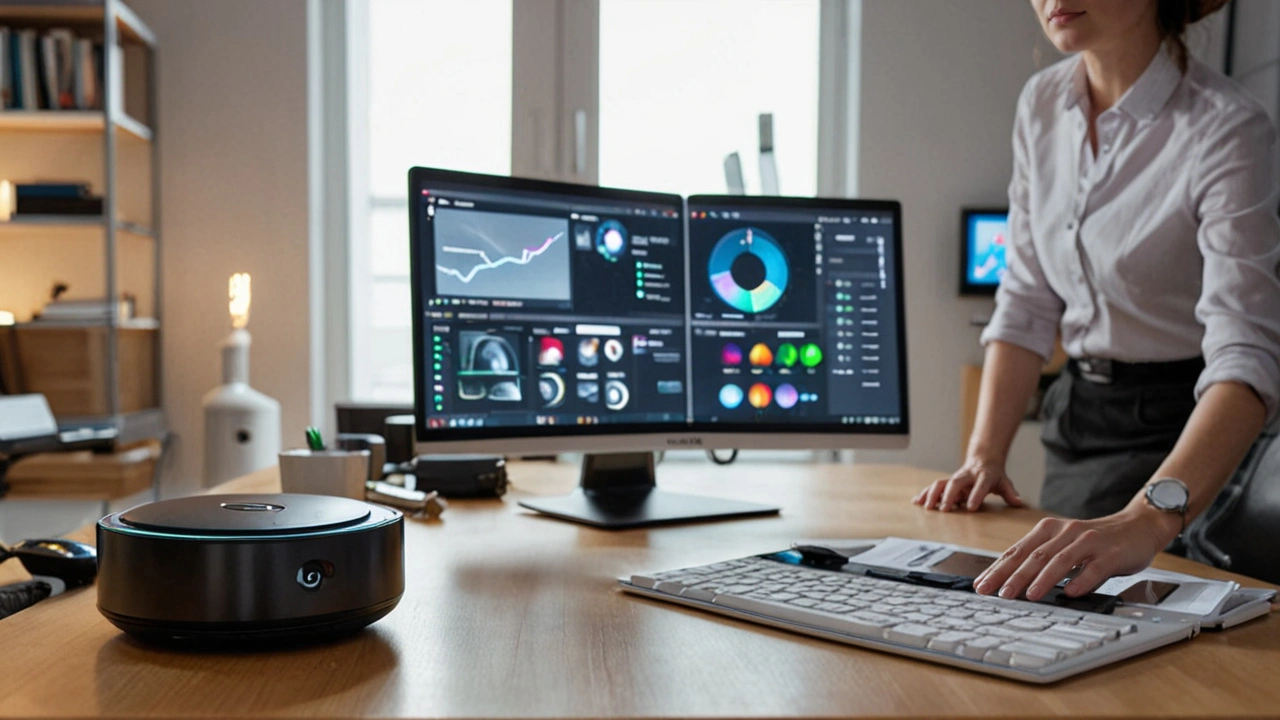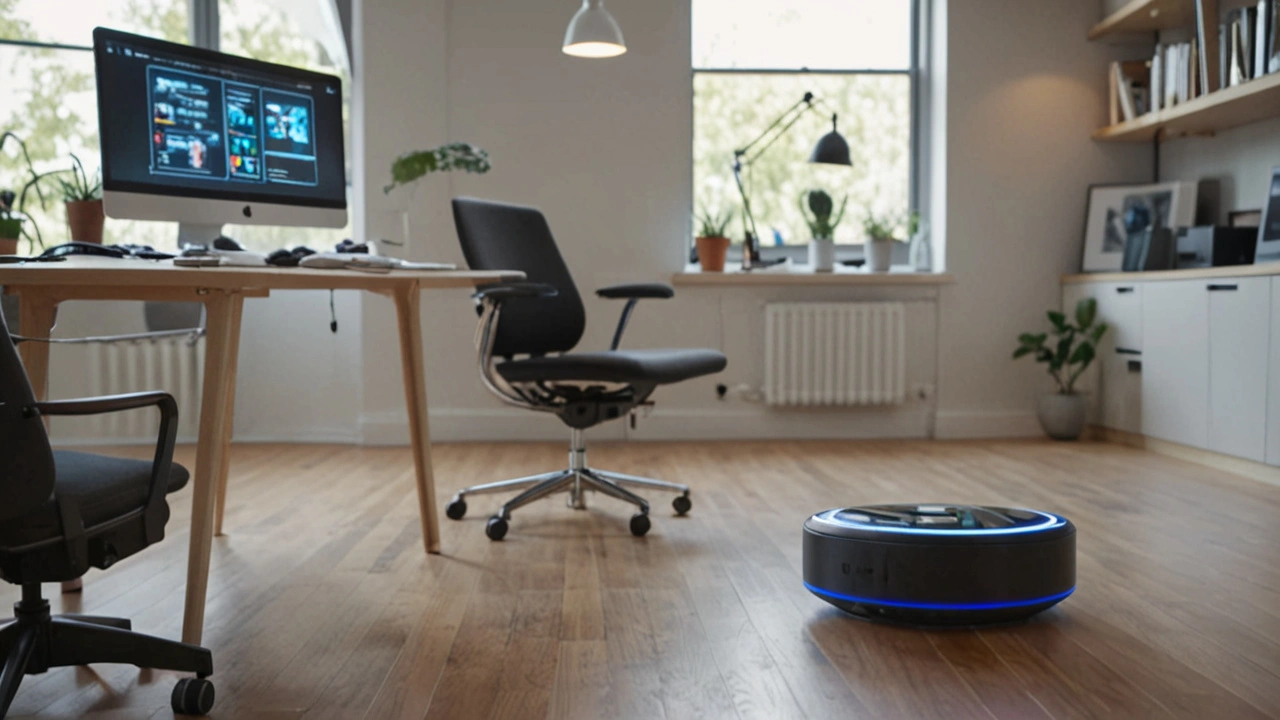Artificial Intelligence, or AI, isn't just a concept for tech experts anymore. It's a tool that's becoming part of our daily lives, and it has the potential to change the way we work and live.
From voice assistants that can help with scheduling to creative applications for designing and writing, AI offers numerous possibilities. The trick lies in knowing how to leverage these capabilities effectively.
This article breaks down some straightforward and practical tips to unlock the full potential of AI. Whether you're new to the technology or seeking to maximize its benefits, these insights will help you navigate the AI revolution with confidence.
- Understanding AI Basics
- Voice Assistants & How to Optimize Their Use
- AI in Creative Fields
- Automating Everyday Tasks
- Security Tips for Using AI
Understanding AI Basics
Artificial Intelligence, or AI, may sound complex, but it's essential to know that it's not magic. AI is about creating machines that can mimic human thought processes and perform tasks that would typically need human intelligence. This can include recognizing speech, making decisions, understanding visual inputs, and translating languages.
The core of AI rests on machine learning, a subset of AI where computers learn from data. This means that the more information they get, the better they perform. For instance, predictive text services on our smartphones improve as it learns from our typing habits. It's not just about storing data; it's about making sense of that data to anticipate needs or provide suggestions.
Neural networks play a big role in AI. Think of a neural network as a computer system modeled on the human brain. It helps computers process information in a way that's similar to how humans do. These networks are crucial for deep learning, where AI can sift through large sets of data and find patterns that humans might miss.
Real-World Applications
AI is everywhere in our daily lives. Voice assistants like Siri and Alexa use natural language processing, a component of AI, to understand and respond to our commands. Recommendations on streaming platforms like Netflix and YouTube come from algorithms that learn our preferences. In healthcare, AI helps in diagnosing diseases by examining medical images faster and sometimes more accurately than a human can.
"Artificial Intelligence is going to change the world more than anything in the history of mankind. More than electricity." – AI pioneer Dr. Kai-Fu Lee
It’s important to note that AI is not just a single technology. It involves various fields like robotics, vision recognition, language processing, and more. Understanding these can give insight into how versatile AI can be and how it might evolve in the future.
Basic Concepts
Let’s talk about some basic terms often used when discussing AI. First, there's machine learning (ML). ML is when machines improve their performance based on experience. Deep learning is a more advanced form, involving neural networks that can handle more complex data structures. Then there's natural language processing (NLP), which enables machines to understand and respond to human language.
Finally, there's the idea of automation. AI-driven automation can handle repetitive tasks, freeing up human workers for more creative jobs. This can be seen in industries ranging from manufacturing, where robots assemble products, to customer service, where chatbots handle initial customer queries.
Voice Assistants & How to Optimize Their Use
Voice assistants, like Alexa, Google Assistant, and Siri, have become essential tech items in many households. But to get the best out of these AI companions, there are some tips and tricks that can make your life easier and more efficient. Voice assistants are capable of doing much more than just setting alarms or playing music. They can manage your calendar, control smart home devices, provide weather updates, and even order groceries. Learning how to optimize their use can significantly enhance their value.
First, it's crucial to understand the range of tasks a voice assistant can perform. For instance, you can create **custom routines** to automate a series of actions with a single command. Imagine saying, "Good morning", and your voice assistant turns on the lights, starts brewing your coffee, and tells you the day's news briefing. This can be especially handy when you're rushing through your morning schedule. Most voice assistants allow you to set up these routines through their respective apps on your smartphone.
Another useful feature is **voice recognition**. By training your AI to recognize different voices in your household, it can deliver personalized responses. This means it can tell your kids about their school schedules while reminding you of your work meetings. This kind of multi-user experience makes voice assistants more than just a generic tool; they become tailored to each family member's needs.
Let's talk about **smart home integration**. A voice assistant can act as a hub for all your smart devices, like lights, thermostats, and security cameras. Integrating your voice assistant with these devices allows you to control them hands-free. For instance, you can adjust the thermostat while cooking or check who's at the door without interrupting your yoga session. This seamless interaction between devices brings a level of convenience that feels futuristic.
Don’t forget about **third-party skills** or **apps**. Many voice assistants offer a variety of external skills that can expand their capabilities. For example, you can enable skills for meditation, language learning, or even games to keep kids entertained. It's worth exploring the app store related to your voice assistant to see what new tools can enhance your lifestyle.
"The biggest advantage of using voice assistants is their potential to save time. Knowing a few commands can speed up everyday tasks," says Emily Roberts, a tech expert at TechSavvy.
**Security and privacy** are also important. While voice assistants can be incredibly helpful, it’s vital to be aware of the security settings. Make sure you regularly review and update your privacy settings to control what data your device collects. Consider using functions like voice match to ensure that sensitive information is only accessible to you.
If you find that your voice assistant sometimes struggles to understand you, try to **retrain the voice model**. Most devices have an option to do this, helping the assistant to better recognize your voice and pronunciation. Clear and concise commands can significantly improve accuracy.
Finally, it's helpful to stay updated with **software updates**. Manufacturers frequently release updates that include new features and security patches. Keeping your device updated ensures it's running with the latest optimizations and protections.
By learning how to fully utilize voice assistants, you’re not just adding a cool gadget to your home, but a genuinely helpful tool that can manage and simplify various aspects of daily life. Take some time to explore these tips and customize your voice assistant to suit your specific needs, and you'll be amazed at how much more productive and enjoyable your days can be.

AI in Creative Fields
The marriage of artificial intelligence and creativity might seem unexpected. AI's role once appeared limited to data and analysis, but it's now playing a breakthrough role in creative fields. From generating art to composing music, AI is helping creators push boundaries they never imagined before.
One of the most impressive developments is AI-generated art. Tools like DeepArt and Google's DeepDream use AI algorithms to transform photos into artwork inspired by famous styles. These tools analyze images and apply brushstrokes and patterns that simulate the styles of iconic artists. The result isn't just a digital filter; it’s a new piece of art created through the collaboration of human input and machine learning.
Music composition has also seen a significant impact from AI. Platforms like AIVA (Artificial Intelligence Virtual Artist) are capable of composing symphonies. AIVA has been trained on thousands of classical pieces and can create original scores that feel organic and emotional. This tool has become so sophisticated that it’s used to score movies, video games, and advertisements. Musicians are finding new inspiration by integrating AI into their creative process, allowing them to experiment with compositions and styles they might not have considered otherwise.
"AI is transforming the creative process. It is giving artists and musicians new tools and approaches to their craft," says Dr. Rebecca Fiebrink, a renowned professor of Creative Computing.
Writers, too, are exploring the edges of creativity with AI. Tools like OpenAI's GPT-4 can generate entire stories or assist in brainstorming sessions. By feeding it prompts, writers can receive instant feedback and suggestions, helping them overcome writer's block or discover new plot twists. The AI’s ability to process vast amounts of data means it can offer historically accurate details or fantasy elements, enriching the narrative in unprecedented ways.
Interactive Media and Storytelling
Interactive experiences benefit greatly from AI integration. Video games, for instance, use AI for creating dynamic environments and character behaviors that adapt based on player actions. This brings a unique experience to each player, ensuring the game feels alive and responsive. Storytelling apps, where the narrative shifts according to user choices, can create incredibly personalized stories with the help of AI. Apps like AI Dungeon provide interactive storytelling where the possibilities are nearly endless, driven by the user's imagination and the adaptive nature of AI.
AI also plays a crucial role in film and video editing. Software can now automatically sort through hours of raw footage to find the best clips, based on criteria set by the editor. This saves time and allows editors to focus on the creative aspects of their projects. Adobe's Sensei platform, for example, uses AI to enhance video and image edits seamlessly, suggesting improvements and automating repetitive tasks.
In conclusion, the interaction between AI and creative fields is expanding rapidly. AI not only augments the creative process but also challenges creators to rethink what is possible. Artists, musicians, writers, and filmmakers are finding that AI can be a valuable collaborator, opening new pathways and helping to bring their most ambitious visions to life. As these technologies continue to evolve, the only limit may be the bounds of human imagination.
Automating Everyday Tasks
Imagine waking up to the smell of freshly brewed coffee, your thermostat already adjusted to the perfect temperature, and your daily schedule neatly planned out. This isn't a scene from a futuristic movie; it's the reality AI can create by automating everyday tasks. With technology advancing rapidly, incorporating artificial intelligence into our daily routines has never been easier or more accessible.
One practical example is the use of smart home devices. Gadgets like smart thermostats learn your preferences, adjusting the temperature without requiring manual input. Similarly, smart lighting systems can be programmed to turn on or off based on your habits, saving you time and energy. According to the U.S. Department of Energy, automated thermostats can reduce energy usage by up to 10% annually.
Voice assistants such as Alexa, Siri, or Google Assistant are another significant part of automating daily tasks. Whether it's setting reminders, sending messages, or even controlling other smart devices in your home, these assistants streamline many daily chores. According to a survey by NPR and Edison Research, around 66 million Americans own a smart speaker, highlighting their growing popularity and usefulness.
Automation with AI doesn't stop at home. In the workplace, AI tools can take over repetitive tasks like sorting emails, scheduling meetings, or managing social media posts. This not only saves time but also reduces human error. Imagine a virtual assistant that schedules your week based on your priorities and sends you daily reminders. It’s like having a personal secretary available 24/7.
"Automation is cost cutting by tightening the corners and not cutting them." — Haresh Sippy, Founder and Managing Director of Tema India Ltd.
For health and fitness enthusiasts, AI can act as a personal trainer, tracking your workouts, suggesting routines, and monitoring progress. Apps like MyFitnessPal use AI to offer personalized diet plans and fitness tips, making it easier to achieve health goals. Keeping track of caloric intake, exercise regimes, and sleep patterns becomes less cumbersome with the aid of AI.
In terms of managing finances, AI-powered apps can handle budgeting, expense tracking, and even provide investment advice. Services like Mint or You Need a Budget (YNAB) offer personalized insights into your spending habits, helping you to make smarter financial decisions. Automation ensures bills are paid on time, avoiding late fees and maintaining a good credit score.
Even your grocery shopping can benefit from AI. Services like Amazon Fresh or Instacart use algorithms to suggest items based on your previous purchases, saving you time and ensuring you never forget essential items. Automated shopping lists and easy reordering make the weekly grocery run a breeze.
Finally, AI can contribute to personal development. Platforms like Duolingo or Coursera use AI to tailor educational content to your learning pace and style. This means you can learn a new language or acquire a new skill at your own convenience, with lessons structured specifically for you.
Incorporating AI to automate everyday tasks streamlines life, allowing you to focus on what truly matters. Whether at home, work, or even in personal pursuits, the possibilities are vast and continually expanding. It's not just about convenience; it's about enhancing the quality of life by making mundane tasks effortless. As AI technology becomes more sophisticated, the future promises even greater innovations, making our daily lives more efficient and enjoyable.

Security Tips for Using AI
With the rapid integration of AI technology into daily living, securing these systems has become a vital task. One of the primary concerns is the protection of personal information. Since voice assistants and other AI tools often gather data to function efficiently, ensuring this information remains private is a top priority. Always be mindful of the permissions you grant to these applications, and routinely review the data they store to safeguard your privacy.
Another essential tip is to use strong, unique passwords for your AI-enabled devices. Reusing passwords across multiple platforms can make you more vulnerable to breaches. It's wise to utilize a reliable password manager to keep track of them. Enabling two-factor authentication (2FA) wherever possible adds an extra layer of security, making it significantly harder for unauthorized parties to access your accounts.
Taking steps to regularly update your software and devices is crucial. Software updates often include security patches that address vulnerabilities. Neglecting these updates can leave your systems exposed to risks. As tech expert Brian Krebs states,
"The single biggest factor in improving your overall cybersecurity posture is to apply updates and security patches in a timely fashion."Thus, keeping systems current can dramatically reduce security threats.
Another aspect to consider is educating yourself on common AI-related scams. Cybercriminals might exploit AI by creating sophisticated phishing schemes, making them harder to detect. Familiarize yourself with the signs of phishing attempts and always verify credentials before providing any personal information. Using reputable security software can also help in identifying and blocking malicious activities.
Additionally, be cautious about the AI applications you download and use. Stick to trusted sources like official app stores, and read reviews and ratings before installing new applications. This practice minimizes the risk of downloading malware disguised as useful tools. It's also wise to regularly delete apps and data you no longer need to limit the amount of potentially sensitive information stored on your devices.
For AI systems that interact with your smart home devices, it’s prudent to secure your home network. Implement a strong Wi-Fi password and consider setting up a guest network for visitors. Use advanced encryption methods such as WPA3 to enhance network security. Regularly monitoring network activity can alert you to any suspicious behavior, enabling prompt action.
Moreover, being aware of the physical security of AI devices matters. Ensure that AI-enabled gadgets like smart speakers and cameras are positioned in secure locations. Disable microphones or cameras on devices when not in use to prevent unauthorized access. Physical security measures complement digital tactics to provide comprehensive protection.
Encouraging an environment of ongoing vigilance and proactive practices can help mitigate potential risks associated with AI. Engaging in forums and discussions about AI can keep you informed about emerging threats and new protective strategies. Being an active part of the tech community makes staying ahead of threats more manageable.
Ultimately, the goal is to enjoy the benefits of AI without compromising security. By mindfully adopting these practices, you can leverage technology while keeping your information safe. Striking this balance allows you to fully embrace the capabilities of AI in a secure and responsible manner.

